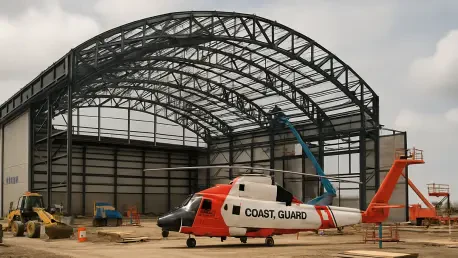I’m thrilled to sit down with Luca Calaraili, a seasoned expert in construction with a deep background in design and architecture. With years of experience in the industry, Luca has a unique perspective on how innovative technologies and tools can transform infrastructure projects, especially in challenging environments. Today, we’re diving into a fascinating topic: the U.S. Coast Guard’s $69 million hangar project at Air Station Barbers Point in Kapolei, Hawai’i. Our conversation explores the purpose and impact of this development, the unique challenges of building in a coastal region, and how such projects enhance critical military operations.
Can you walk us through the core purpose of the hangar project at Air Station Barbers Point in Hawai’i?
Absolutely. The main goal of this $69 million project is to construct two new membrane tension hangars to house the Coast Guard’s HC-130J Super Hercules aircraft. These are long-range search and rescue planes vital to operations across a massive 12.2 million-square-mile area in the Oceania District. The hangars will provide fully enclosed, weather-protected spaces for maintenance and shelter, ensuring these critical assets are ready for action at a moment’s notice. Beyond just storage, they’re about enhancing operational efficiency in a region where timely response can mean the difference between life and death.
What’s driving the need for new facilities at this specific location?
The current setup at Barbers Point is simply not up to par. Right now, the base can only partially enclose one of these massive aircraft, which have a wingspan of about 133 feet. That leaves the other planes exposed to Hawai’i’s harsh saltwater environment, which is incredibly corrosive and can degrade critical components over time. These new hangars will offer full protection, extending the lifespan of the aircraft and reducing maintenance headaches caused by constant exposure to the elements.
Could you elaborate on the role of the HC-130J Super Hercules in Coast Guard operations?
Of course. The HC-130J Super Hercules is a powerhouse for long-range search and rescue missions. In the Oceania District, these aircraft handle everything from maritime surveillance to life-saving operations over vast ocean expanses. They’re often the first responders in remote areas where no other help can reach quickly. Having proper shelter and maintenance facilities isn’t just a luxury—it’s a necessity to keep these planes mission-ready, ensuring they can perform heavy air transport and surveillance without downtime due to preventable damage.
What are some of the key components being built as part of this contract?
Beyond the two primary hangars, the project includes a range of supporting facilities. We’re talking about an aviation materials office, dedicated aircraft maintenance shops, office spaces for personnel, a locker room, and load cages near the hangars. These additional spaces are crucial for streamlining operations. They provide the infrastructure needed for efficient repairs, inventory management, and crew readiness, all of which directly support the Coast Guard’s ability to execute their missions effectively.
How is the timeline shaping up for this project, and what might the construction phase look like?
Construction is slated to kick off in 2026, with completion expected by early 2028. That’s a roughly two-year window to get everything built and operational. During this period, there’s a strong focus on minimizing disruptions to the air station’s day-to-day activities. It’s a busy base, so coordinating construction around active operations will be a priority. The team will likely implement strict scheduling and safety protocols to ensure the Coast Guard can keep flying missions without significant interruptions.
What unique challenges come with building hangars in a coastal area like Kapolei?
Coastal construction always brings a distinct set of hurdles, and Kapolei is no exception. The salty, humid environment can wreak havoc on materials if they’re not chosen carefully, so corrosion-resistant designs are a must. Additionally, the area faces strong winds and occasional extreme weather, so the hangars need to be engineered to withstand those forces. There’s also the logistical challenge of working on an active military base in a remote location—getting materials and equipment to the site isn’t as straightforward as on the mainland. All these factors require meticulous planning and innovative design solutions.
How does a project like this contribute to broader military infrastructure goals?
This project is a great example of how targeted infrastructure investments can bolster national security and emergency response capabilities. By upgrading facilities like these hangars, the Coast Guard can maintain a higher state of readiness, especially in a strategically important region like the Pacific. It’s not just about protecting aircraft; it’s about ensuring the U.S. has the operational edge to respond to crises, conduct surveillance, and save lives across millions of square miles. Projects like this also set a standard for modernizing aging military infrastructure nationwide.
What’s your forecast for the future of military construction projects in challenging environments like coastal regions?
I think we’re going to see a growing emphasis on resilience and sustainability in military construction, especially in coastal areas. With climate change intensifying weather patterns, future projects will need to prioritize designs that can endure harsher conditions—think stronger materials, elevated structures to combat flooding, and energy-efficient systems to reduce operational costs. Technology will play a huge role too, from advanced modeling software for predicting environmental impacts to modular construction techniques that speed up timelines in remote locations. The focus will be on building smarter, not just bigger, to meet the evolving needs of agencies like the Coast Guard.









